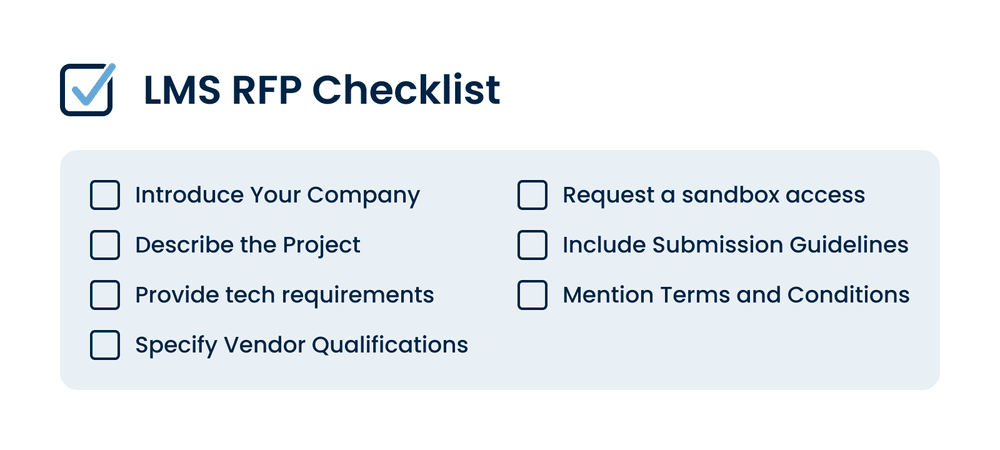In this article, we’ll cover everything you need to know about an LMS RFP:
what it is (just in case), important reasons to use it, outstanding benefits, common mistakes, and sound tips for crafting it to achieve your goals.
What’s more, there is a downloadable template included to help you simplify the LMS selection process.
What’s an LMS RFP?
Request for Proposal (RFP) is a common term in the business world. In fact, it is a document used by organizations looking for various solutions.
Thus, when organizations are choosing an LMS platform for their needs, they use an LMS RFP (Learning Management System Request for Proposal).
The LMS RFP serves as a formal invitation for potential vendors to submit their proposals.
It mentions all the necessary technical requirements, criteria, LMS features, and goals to be achieved.

Why you need an LMS RFP
Why use LMS RFP after all? Here are some reasons for you to consider:
A cost-saving tool
It is always easier and faster to find the right LMS if you know exactly what you are looking for. Here is how to figure this out: put it into writing.
By using LMS RFP, you can accurately and concisely organize:
- What you need and expect LMS to do;
- Which business goals you plan to achieve;
- Which features are necessary, which are nice-to-haves, and which you can comfortably disregard.
The LMS RFP’s transparency will ensure that you pay a reasonable price and only for what you need. As a result, you will get a balance between your budget and requirements.
LMS RFP is also a great tool for evaluation, as you can always analyze the chosen solution efficiency by turning to the document again.
Time & effort saver
In fact, LMS RFP is a win-win for both vendors and seeking organizations.
LMS RFP informs vendors about important issues, such as budget, deadlines, the necessity to employ a certain technology, and so on, before they start presentation.
Therefore, you save time and effort on communicating, analyzing, and considering options that won’t really help you.
LMS vendors will also be thankful for clear descriptions, as it benefits them in a similar way.
Moreover, LMS RFP can contribute to the LMS market development as providers also analyze various requests for proposals to understand their customers’ needs better.
As a result, it helps them tailor their products and services accordingly and provide high-quality solutions on the market.
A risk management instrument
By providing a comprehensive overview of the solution, including technical specifications, timelines, and cost estimates, you avoid misunderstandings and reduce risks.
Both parties will align their expectations and ensure a successful collaboration.
Additionally, this level of detail allows for effective project planning and resource allocation, resulting in timely delivery and customer satisfaction.
How to craft an LMS RFP?
Now, let’s go through key elements of a comprehensive LMS RFP and tips for crafting it successfully.

Introduce yourself
Introduce your company to potential vendors: describe your industry, relevant objectives, recent technology stack, the purpose of LMS RFP, and others.
Include all the information you may find necessary. For example, if you used any platforms before, and your experience working with them.
Describe the project
Give an overview of the LMS project’s objectives, implementation schedule, and financial restrictions.
It is also important to mention the number of potential users, their roles (publisher, learner, administrator, etc.), courses you already have, and materials you want to upload.
Provide tech requirements
Mention all the necessary features, scenarios of using them, functionality, and other specific requirements, such as scalability and compatibility.
List the applications, software, and services you intend to use with an eLearning platform.
Ask questions about content and course management, reporting formats, and assessment tools.
To avoid buying an LMS that is unable to read the structure of your online courses, determine whether any integrations are necessary or whether you can live without them.
Specify vendor qualifications
Clarify what your ideal vendor looks like. Include industry experience, post-implementation customer support capabilities, training options, short-term and long-term costs, and desirable pricing structure.
Don’t hesitate to ask for case studies, client testimonials, awards, and other references.
There is more to choosing the best vendor. That’s why we have written an article for you to probe deeper.
Request sandbox access
A sandbox is an environment designed to mimic the appearance and functionality of a fully developed system. If such an option is available, you should totally go for it.
Although it won’t have every function accessible, it will provide administrators and users an opportunity to explore the platform, find potential problems, and familiarize themselves with the user interface (UI).
Include submission guidelines
Potential vendors will definitely be grateful for this information. Also, you will avoid getting too many typical questions and save your time.
Therefore, provide a required format for their submissions (structure), criteria for selection, process of evaluation, deadlines, and contact information.
Mention terms and conditions
Provide all the necessary legal information, such as company policies on data security and privacy and requirements related to compliance.
Additionally, it is crucial to highlight any industry-specific regulations or standards that the company adheres to in order to maintain compliance and safeguard sensitive information.
Common LMS RFP mistakes to avoid
There are several mistakes that can get in the way of a successful LMS selection process. Let’s discuss them in detail.
1. Disregarding growth
If you want an LMS to serve you efficiently and for a long period of time, considering your company’s future growth is a must.
To ensure your LMS can accommodate it, assess such factors as scalability, expansion of training strategies, and long-term eLearning goals.
Then, analyze pricing structures, support costs, and admin training options in each LMS quote. This will help you determine which LMS platform offers the best return on investment (ROI) and can adapt to your company’s evolving needs.
2. Not establishing clear evaluation criteria
Not having a defined evaluation procedure for vendor proposals is a common mistake.
It is important to provide your assessment criteria in the RFP clearly. This will not only simplify the procedure for vendors but also enable you to evaluate offers unbiasedly and choose the ideal provider for your requirements.
Additionally, establishing a timeline for the evaluation process can help keep the project on track and ensure timely decision-making.
Also, don’t forget to provide feedback to vendors on their proposals! This will help improve communication and strengthen relationships for future collaborations.
3. Communicating poorly
Last but not least, don’t underestimate communicating with vendors throughout the whole process.
Set clear expectations, respond to their inquiries promptly and fully, and provide regular updates on the status of the evaluation.
As a result, you will build trust and transparency in the vendor relationship, ultimately leading to successful partnerships.
LMS RFP template
Not sure where to begin? Here you go!
To speed up and simplify the search process for you, we offer a user-friendly LMS RFP template example.
With its help, you can ensure that all necessary information is included in your request for proposal, making it easier for vendors to understand your needs and provide accurate responses.
Save time and effort by using our expertly curated template. Start using the template by clicking here.
Making the most of your LMS RFP
A well-written LMS RFP points your business or organization in the direction of the best learning management system.
Through precise specification, a well-structured request for proposal, vendor assessment, and in-depth product trials, you will get the ideal LMS platform that fits your organization’s particular requirements and objectives.
Need some help? We provide consultations and custom eLearning solutions for businesses across 15+ industries. Contact our experts and get your questions answered and concerns resolved.






